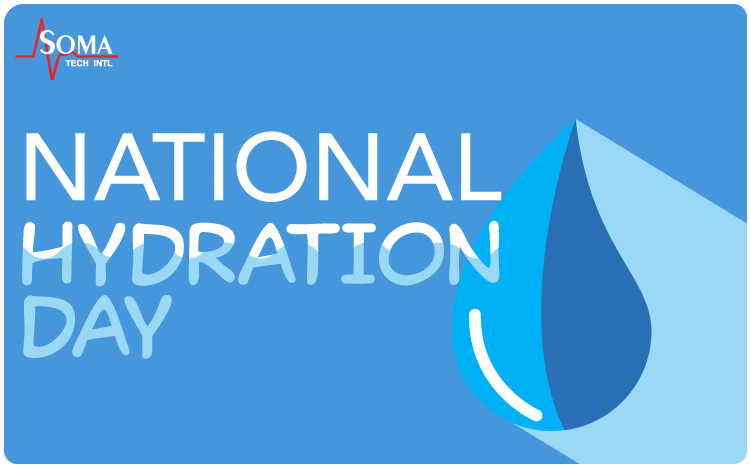National Hydration Day | June 23 | 2020
June 23, 2020
What is Hydration?
Almost all forms of life, including humans require water for hydration. Water makes up about 60% of your body weight. Without water, our bodies have a desire to drink which is referred to as thirst. When there is a decline in the level of water inside your body it’s called dehydration. On the opposite side overconsumption of water can lead to water intoxication which can dangerously dilute the concentration of salts in the body. Continue reading to learn more about hydration!
Why is Hydration Important?
Being well-hydrated can help improve sleep quality, cognition, and mood. Dehydration can affect everyone differently. Young children and infants are most likely to experience severe diarrhea and vomiting. Infants and children are especially vulnerable to dehydration. Young children often can’t tell you they are thirsty or get water for themselves. As you age your body’s fluid reserves become smaller, your ability to conserve water is reduced, and your sense of thirst gets reduced. It’s important to continue drinking water and staying hydrated even when you are not thirsty.
Thirst isn’t always a reliable indicator of the body’s need for water. Many people, even older adults, don’t feel thirsty until they are already dehydrated. Along with drinking water, eating foods high and water such as fruits and vegetables can help prevent dehydration.
How Much Water Should Drink?
The human body requires a daily intake of water to maintain a normal physiological function. The USDA recommends that the average, healthy adult living in a temperate climate needs:
- Males need 3.7 liters (About 1 gallon)
- Women need 2.7 liters (About 0.75 gallons)
This water recommendation covers total fluid intake from water, other beverages, and food. About 20% of your daily fluid intake will come from food. This water consumption recommendation is an average and does not take into consideration other external factors like:
- Exercise
- Climate
- Overall health
What Are the Health Benefits of Water?
Every cell, tissue, and organ within the body relies on water to function properly. It helps deliver oxygen, nutrients, and hormones to the cells. Water also gets rid of waste from the body through urination, perspiration, and bowel movements. It helps keep your temperature normal and even lubricates your joints and helps supply a little bit of cushion.
How to Test Your Hydration Levels
Skin Test
You can test your hydration level with a skin elasticity or turgor test. This can help determine if you are dehydrated. A decreased skin turgor is indicated when the skin on the back of the hand is pulled up and does not return to its original state. Gently pinch the skin on your arm (adults) or stomach (child) to make a tent shape. Let the skin go, and check to see if the skin springs back to normal. If the skin does not spring back to normal, you might be dehydrated.
Nail Capillary Test
After your nail is pinched, it whitens. This happens because blood is forced out. Normally blood returns in two seconds or less. If you’re dehydrated it might take longer for the area to return to a pink shade. Hold the hand you’d like to test above your heart. Press or pinch your nail bed until it turns white. Release the pressure and count how many seconds it takes for the color to turn to your nail bed.
Symptoms of Dehydration
Dehydration can be serious. There are several ways to tell if you’re dehydrated listed below:
1. Skin
You lose moisture through your skin when the air temperature is both hot and cold. When the air is hot, you lose moisture through sweating. When it’s cold you also lose moisture because of the dryer air. Your skin may be showing some signs of dehydration if you notice roughness or flaking, flushing or redness, or tightening or shrinking of your skin.
2. Mouth
Your body needs plenty of water to make saliva or spit. When you’re dehydrated you have less saliva. Your mouth and tongue may feel dry or sticky when you’re dehydrated.
3. Urine
You also might be able to tell if you are dehydrated by looking at your urine. If it’s dark yellow, it could mean you have mild to severe dehydration. You usually can tell if you have a healthy hydration level if your urine is very light in color.
Explore Other Blog Items By Category
Recent Posts


Surgical Microscope Rentals


1 comment